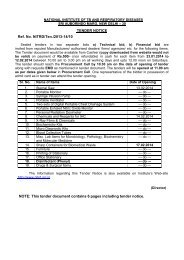October - LRS Institute of Tuberculosis & Respiratory Diseases
October - LRS Institute of Tuberculosis & Respiratory Diseases
October - LRS Institute of Tuberculosis & Respiratory Diseases
Create successful ePaper yourself
Turn your PDF publications into a flip-book with our unique Google optimized e-Paper software.
REVIEW ARTICLE Ind, .J. Tub., 1986, 33, 155<br />
ADULT RESPIRATORY DISTRESS SYNDROME (ARDS)<br />
D.D.S. KULPATI*<br />
ARDS represents a final common pathway<br />
<strong>of</strong> injury due to a variety <strong>of</strong> massive, <strong>of</strong>ten<br />
unrelated insults to the lungs, resulting in<br />
respiratory distress, decreased pulmonary<br />
compliance and severe arterial hypoxaemia<br />
along with acute diffuse infiltrative lung lesions.<br />
It is a form <strong>of</strong> acute respiratory failure with<br />
noncardiogenic pulmonary oedema (Fein et al,<br />
1982; Petty and Fowlder, 1982; Rinaldo and<br />
Rogers., 1982: Tranbaugh and Lewis, 1982;<br />
Bernard and Brigham, 1985).<br />
The awareness <strong>of</strong> Adult <strong>Respiratory</strong><br />
Distress Syndrome can be traced to World<br />
War II but the magnitude and nature was<br />
appreciated in Vietnam War. Soldiers with<br />
nonthoracic injuries were treated and sent<br />
to regional hospital where during convalescence<br />
unexpectedly life threatening respiratory distress<br />
occurred. Lungs seemed to be full <strong>of</strong> water.<br />
It was called ‘wet lung’, ‘shock lung’ or ‘Da-<br />
Nang lung’ - the site <strong>of</strong> hospital in Vietnam.<br />
Various synonyms (Wilson and Bone, 1979)<br />
for ARDS are given in Table I.<br />
The term was coined (Ashbaugh et al, 1967)<br />
due to clinico-pathologic similarities with<br />
infantile respiratory distress syndrome (1RDS).<br />
However, in infants, the alveoli are small,<br />
the chest wall is highly compliant, distending<br />
pressure at the end <strong>of</strong> expiration is small and<br />
these combined with lack <strong>of</strong> decrease in surface<br />
tension at the alveolo-capillary membrane leads<br />
to atelectasis which is characteristic <strong>of</strong> IRDS,<br />
while, in ARDS, diffuse injury to pulmonary<br />
capillary membrane leads to increased permeability<br />
and pulmonary edema. The surfactant<br />
deficiencies are secondary to diffuse lung<br />
injury in ARDS in contrast to a deficiency<br />
<strong>of</strong> surfactant as primary eticlogy in IRDS.<br />
Similar clinical pr<strong>of</strong>ile <strong>of</strong> ARDS may result<br />
from different specific conditions which may<br />
require specific diagnostic and therapeutic<br />
measures. Thus, this term may obscure clinically<br />
important differential diagnosis with serious,<br />
therapeutic implications. Therefore, specific<br />
etiologic conditions should always be retained<br />
with this diagnosis. The term ARDS emphasises<br />
the respiratory element <strong>of</strong> the syndrome<br />
but conceals the fact that there is extensive<br />
damage throughout the body (Wallace and<br />
Spence, 1983).<br />
Etiology : ARDS occurs following a variety<br />
<strong>of</strong> catastrophic events which represent risk<br />
factors (Table II). These include shock,<br />
overwhelming in feet ions, trauma, aspiration<br />
and damage due to various drugs and. physiochemical<br />
agents. More and more specific<br />
entities are being recognized to be associated<br />
with ARDS, Some risk factor for the development <strong>of</strong><br />
ARDS are more lik ely to produce the syndrome<br />
than other. A recent study suggested that sepsis<br />
syndromeu results in development <strong>of</strong> ARDS<br />
in 36 % whereas less than 1%, <strong>of</strong> patients<br />
undergoing cardiopulmonary bypass, develop<br />
ARDS (Demling. 1980; Modig, 1980; Pope et al,<br />
1983).<br />
Pathogenesis : Different noxious<br />
stimuliproduce uniformly diffuse damage to<br />
alveolo-capillary membrane. Damage to either<br />
alveolar or capillary surface <strong>of</strong> this membrane<br />
can produce ARDS (Fig.I ) Diffuse alveolar<br />
injury i.e. to alveolar lining cell, type I alveolar<br />
cell results from contact with toxins like gasses<br />
hydrocarbons or gastric acid. Diffuse capillary<br />
endothelial injury is probably the commonest<br />
mechanism <strong>of</strong> ARDS. Implicated humoral and<br />
cellular mechanisms <strong>of</strong> capillary endo-thelial<br />
injury are :<br />
4. Others : Serotonin, bradykinin,histamine,<br />
B-endorphin, complement, platelets, free<br />
fatty acids.<br />
5. Direct injury :Gastric acid, hyperoxia<br />
toxins<br />
Neutrophil injury<br />
Thu polymorphonuclear neutrophil, by<br />
producing potentially toxic ,edoators <strong>of</strong> injury,<br />
plays a central role in the enesis <strong>of</strong> certain forms<br />
<strong>of</strong> ARDS. Fowler et al (1983) and Fowler et al<br />
(1983) demostrated large numbers <strong>of</strong><br />
*Pr<strong>of</strong>essor and Head, Department <strong>of</strong> Medicine and Respirators<br />
Associated LNJPN and G.B. Hant Hospital, New Delhi-110002.<br />
Unit Maulana Azad Medical College,
















